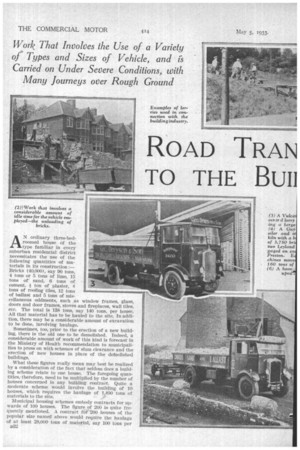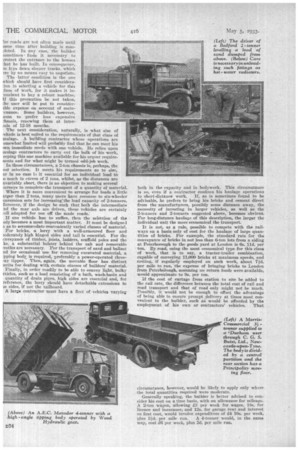ROAD TRAN TO THE BUI1 SPORT VITAL DING TRADE
Page 106

Page 107

Page 108

If you've noticed an error in this article please click here to report it so we can fix it.
AN ordinary three-bedroomed house of the type familiar in every suburban residential district necessitates the use of the following quantities of materials in its construction :— Bricks (40,000), say 90 tons, 4 tons or 5 tons of lime, 15 tons of sand, 6 tons of cement, i. ton of plaster, 4 tons of roofing tiles, 12 tons of ballast and 5 tons of miscellaneous oddments, such as window frames, glass, doors and door frames, stoves and fireplaces, wall tiles, etc. The total is 138 tons, say 140 tons, per house. All that material has to be hauled to the site. In addition, there may be a considerable amount of excavation to be done, involving haulage.
Sometimes, too, prior to the erection of a new building, there is the old one to be demolished. Indeed, a considerable amount of work of this kind is forecast in the Ministry of Health recommendation to municipalities to press on with schemes of slum clearance and the erection of new houses in place of the defuolished buildings.
What these figures really mean may best be realized by a consideration of the fact that 'seldom does a building scheme relate to one house. The foregoing quantities; therefore, need to be multiplied by the number of houses concerned in any building contraet. Quite a moderate scheme would involve the building of 10 houses, which requires the haulage of 1,400 tons of materials to the site.
Municipal housing schemes embody contracts for upwards of 100 houses. The figure of 200 is quite frequently mentioned. A contraet fotv"200 houses of the popular size named above would require the haulag-ce of at least 28,000tons of material, say 100 tons per
D32 working day, on the assumption that the contract was to be completed within a year. These quantities do not include further tonnage involved in excavation and demolition.
The haulage in connection with the building of houses throughout the country is in excess of 10,000,000 tons per annum. In view of this fact, it is not surprising that activity in the building industry is so quickly reflected in the prosperity of road haulage. A peculiar feautre of this class of road transport is the divergent nature of the materials to be dealt with, a condition which necessitates a corresponding variety in the types of v.ehicle used for their handling. Furthermore, the variety of materials and the complication of the problem of haulage are intensified in the case of larger •types -of structure such as factories, warehouses and business premises in the construction of which much girder work and masonry is involved.
• The demand for variation in capacity is, too, almost as great as that of type. This factor is also. governed by the distance that the material has to. be transported and,again, by the scope for the operations of the building contractor himself.
A small man building an occasional house or two at a time can manage with one small vehicle.. A big contractor must provide for the occasional handling of 7ton and S-ton girders, each in one piece, making it essential for him to have a vehicle of that capacity, althdugh the rest of his work could probably be effected with smaller machines. •
Again, a special condition of building work is the necessity or negotiating rough ground. This circumstance prevails throughout the execution of a contract, D33
or roads are not often made until some time after building is eom)letecl. In any case, the builder sometimes finds it necessary to )rotect the entrance to the houses that he has built. In consequence, 2e ltlys down sleeper tracks, which are by no means easy to negotiate. The •latter condition is the one which should have first consideration in selecting a vehicle for t.12;s :lass of work, for it makes it inunbent to buy a robust machine. if this precaution be not taken, the user will be put to considerible expense on account of mainenance. Some builders, however, seem to prefer less expensive tassis, renewing them at interTals of 12-18 months.
The next consideration, naturally, is what size of 7ehicle is best suited to the requirements of that class of mulage. A building contractor whose operations are omewhat limited will probably find that he can meet his iwn immediate needs with one vehicle. He relies upon mulage contractors to carry out the bulk of his work, ceping this oue machine available for his urgent require!lents and for what might be termed odd-job work.
In thnse circumstances, a 2-ton chassis is, perhaps, the est selection. It meets his requirements as to size, or in no case i•s it essential for an individual load to e much in excess of 2 tons, whilst, as the distances are invariably short, there is no objection to making several nirneys to coniplete,the transport Of a quantity of material. Where it is more convenient to arrange for loads a little arger than 2 tons, many users have recourse to six-wheeler °aversion sets for inereasinethe load capacity of 2-tanners. loreover, if the design be such that both the intermediate ad the rear axle are driven, these vehicles are certainly len adapted for nse off the made roads.
If one vehicle has to suffice, then the selection of the ody becomes a most important matter. It must be designed I) as to 'accommodate conveniently varied classes of material. For bricks, a lorry with a well-armoured door and mderately high hinged sides and tail is essential. For the onveyance of timber, joists, ladders, scaffold poles and the ke, a substantial bolster behind the cab and removable ;•estles are necessary. For the transport of sand and ballast ad for occasional use for removing excavated material, a .pping body is required, preferably a power-operated threemy tipper. Then, again, the movable floor has distinct writs for dealing with certain classes of builders' material. Finally, in order readily to be able to convey light, bulky rtieles, such as a load consisting of a bath, wash-basin and quantity of drain pipes, high sides are essential and, for reference, the lorry should have detachable extensions to 2e sides, if not the tailboard.
A large contractor must have a fleet of vehicles varying
both in the capacity and in bodywork. This circumstance is so even if a contractor confines his haulage operations to 81;mi-distance work. If, as is sometimes found to be advisable, he prefers to bring his bricks and cement direct from the manufacturers, possibly some distance away, the necessity a investing in larger vehicles, as well as the 2-tenners and 3-tanners suggested above, becomes obvious. For long-distance haulage of this description, the larger the individual unit the more economical the transport.
It is not, as a rule, possible to compete with the railways on a basis only of cost for the haulage of large quantities of bricks. FOr example, the standard rate for the conveyance of bricks in not less than 6-ton lots from a siding at Peterborough to the goods yard at London is 6s. 11d, per ton. By road, using the most economical type for this class of work, that is to say, a tractor-trailer combination, capable of conveying 11,000 bricks at maxim= speeds, and costing, if regularly employed on such work, about 'TN. per mile to run, the expense of bringing bricks to London from PeterbOrough, assuming no return loads were available, would approximate to 98. per ton.
If the cost of cartage from station to site be added to the rail rate, the difference between the total cost of rail and road transport and that of road only might not be much. Possibly, it would not be enough to offset the advantage of being able to ensure prompt delivery at times most convenient to the builder, such as would be afforded by the employment of his own or contractors' vehicles. That circumstance, however, would be likely to apply only where the total quantities required were moderate. . Generally speaking, the builder is better advised to consider his cost on a time basis, with an allowance for mileage. A 2-ton wagon, allowing £3 per week for wages, 18s. for licence and insurance, and 12s. for garage rent and interest on first cost, would involve expenditure of £4 10s. per week,
plus 33d. per mile run. A 4-tanner would, in the same way, cost 16 per week, plus 5d. per mile run.




























































































































































































